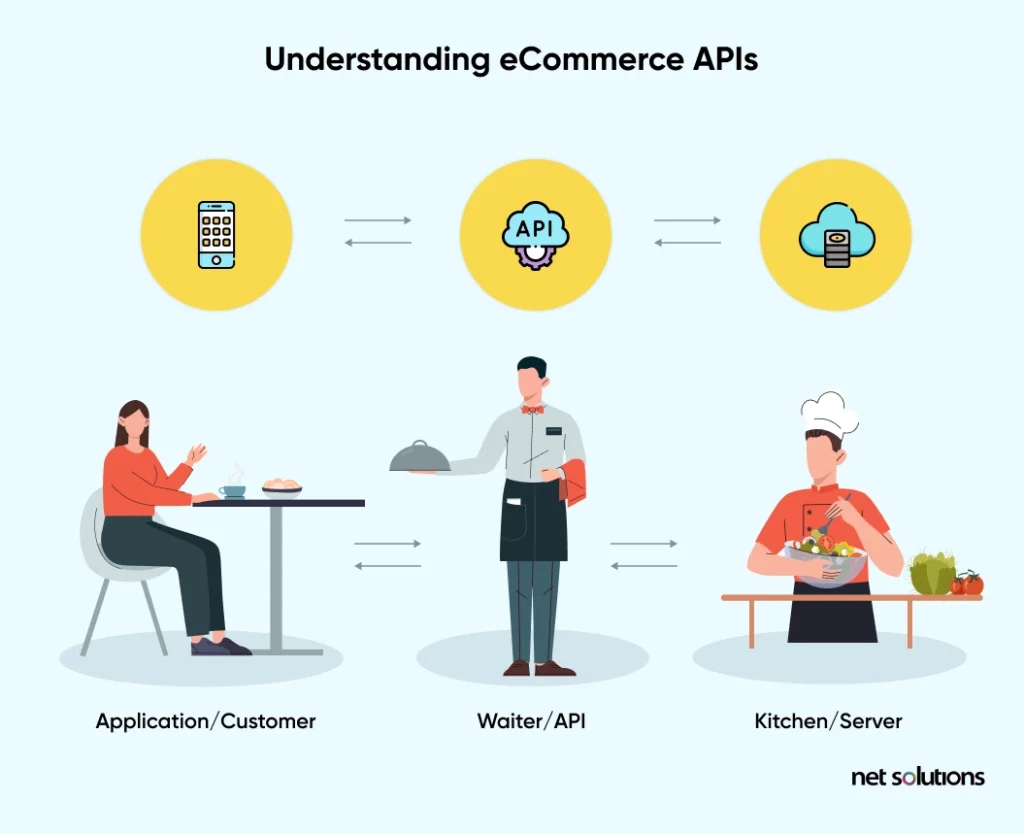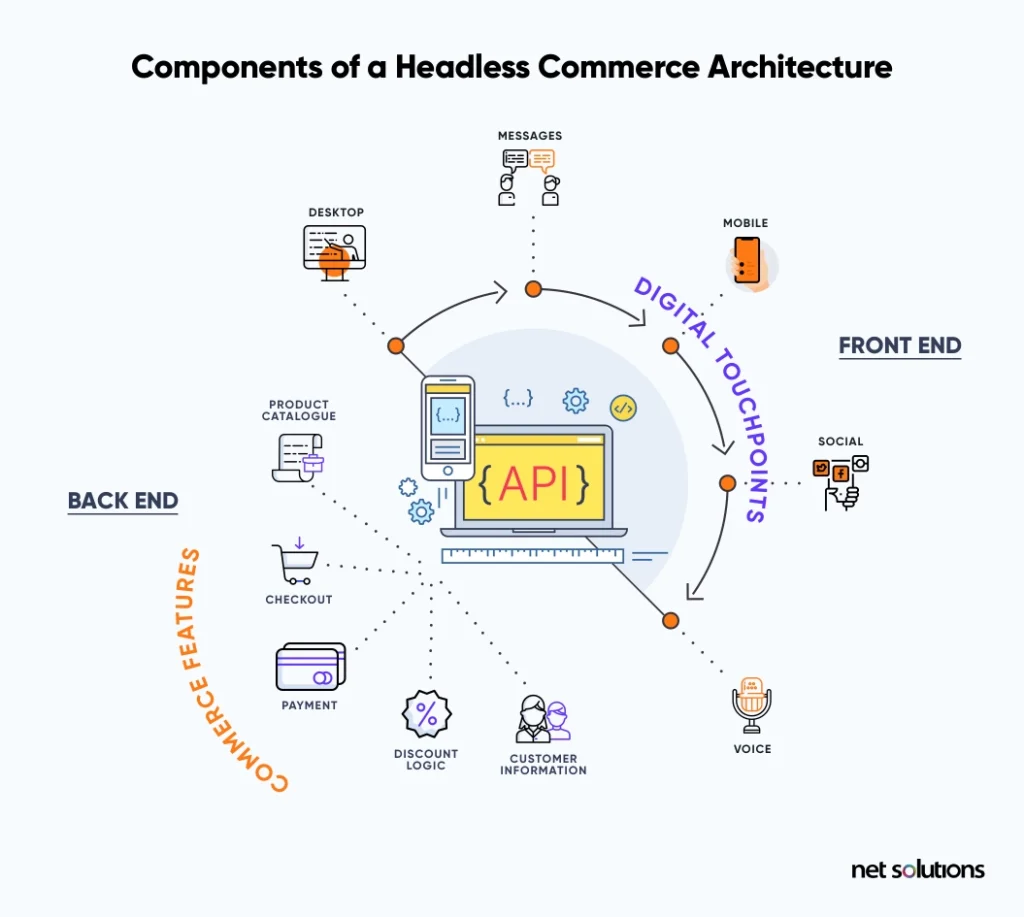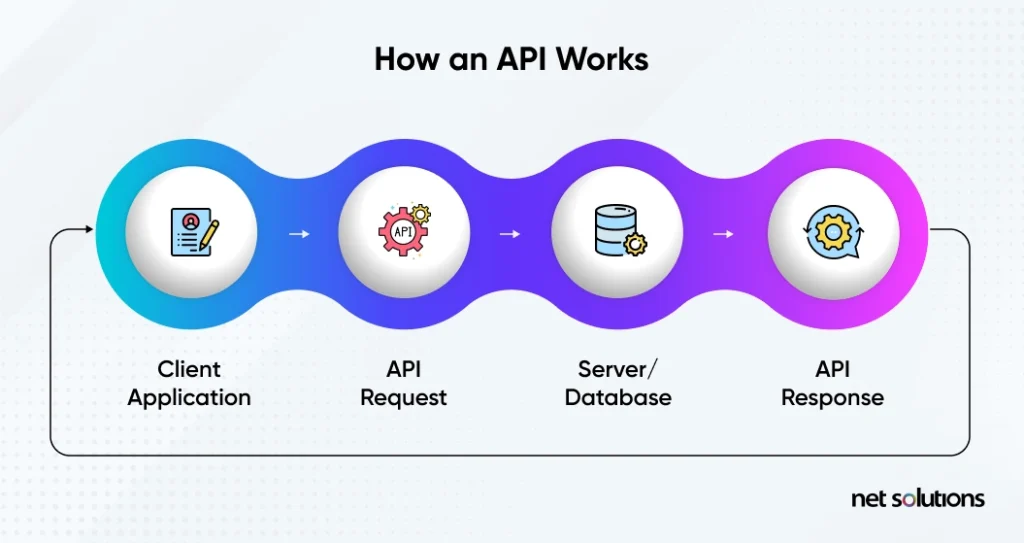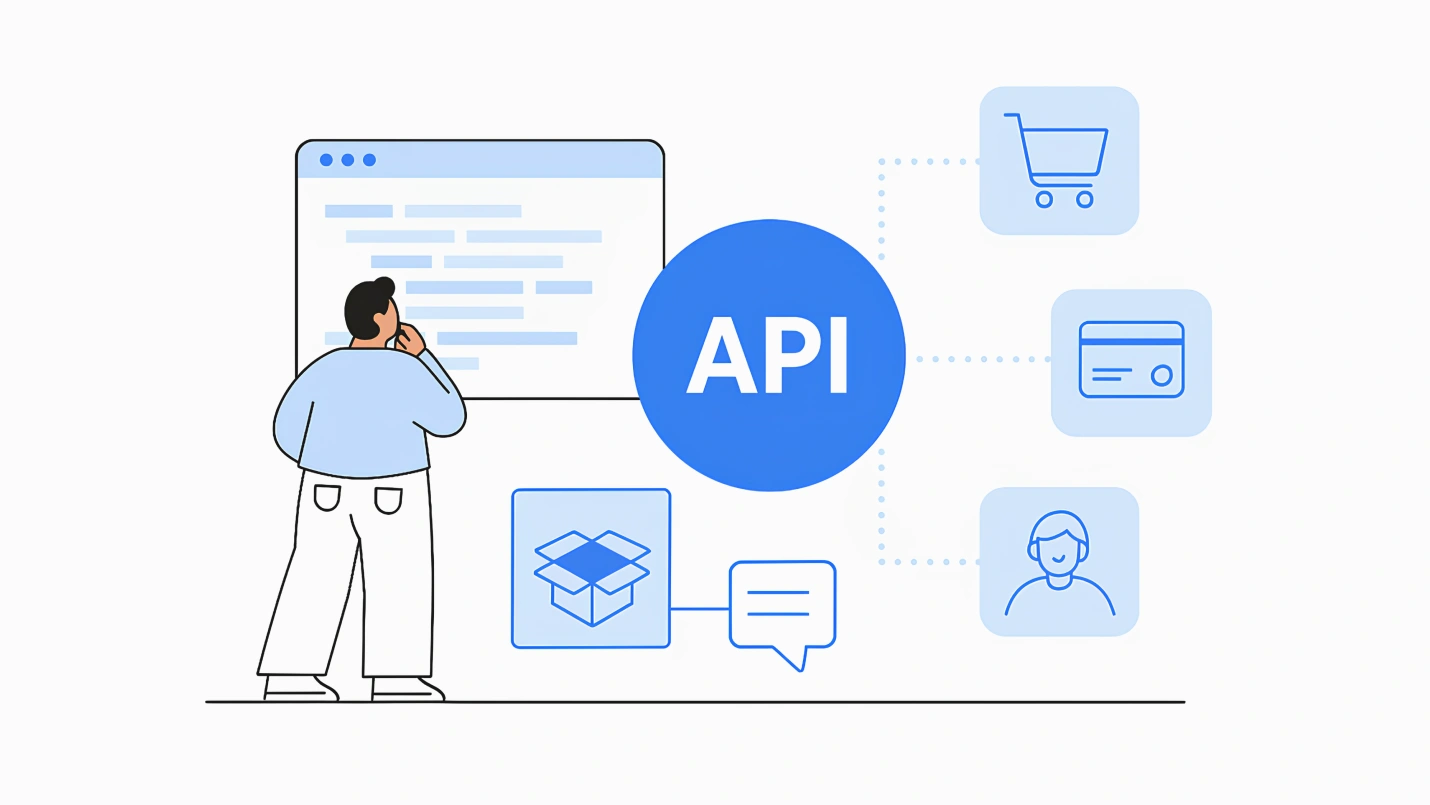An Application Programming Interface (API) is a kind of software that allows two or more systems to communicate across a two-way connection or bridge. What is an eCommerce API? An eCommerce API is an API that is specifically designed to support eCommerce services, connecting an eCommerce platform to transfer data to other integrated services.
This guide will discuss the eCommerce API and various eCommerce APIs to drive the growth and performance of your online retail store.
Understanding eCommerce APIs
An API is a software intermediary, a set of communication protocols and routines allowing two programs to talk. The API is the messenger or “waiter” communicating between two system parts.

What are APIs in eCommerce? To extend the analogy of the wait staff, an eCommerce API allows for applications inside and outside the eCommerce platform (e.g., Magento, Shopify, BigCommerce) to communicate. As more and more retailers embrace headless commerce, which decouples the front and back end, the use of APIs includes communicating between the back-end and the front-end(s) – where the data is presented (e.g., mobile, desktop, social) and what can be a back-end that is made up of the commerce platform and all the supporting discrete services that support the solution (microservices).

APIs are divided roughly into three core types:
- Public / Open / External APIs – APIs (free/paid) offered to the outside world that expose the core platform’s data, functionality, or services, allowing third parties to integrate into their applications.
- Partner APIs – APIs offered privately between business partners for data sharing, often leveraged when data is more sensitive, and use must be restricted with tighter authorization, authentication, and security. This is the most commonly used eCommerce API type.
- Private APIs – APIs that internal developers use to establish connections between internal systems or products.
eCommerce APIs: What Are They and How to Use Them
How do eCommerce APIs work?
An eCommerce API provides two-way communication that will send/request/push a request, format it appropriately to its destination, and do the same for the response.

When and why do we use eCommerce APIs
APIs are a massive advantage in digital commerce development, allowing systems to ‘extend’ capabilities to complete third-party solutions and services, regardless of each piece’s data structures or technology stacks. This allows for data sharing and connectivity that supports high performance. In contrast, separate systems allow retailers to choose the best services, enabling each service to scale as needed and deliver the best front-end experience to each device or platform. APIs are the glue that holds this together, driving the orchestration.
52% of retailers note that “APIs accelerate innovation by enabling partners to leverage digital assets at scale,” helping drive business value – as discussed in the future benefits section.
APIs will become the foundation for business resilience and growth in retail over the next five years. – Google Cloud.
Types of eCommerce API Models
eCommerce APIs can be organized into three models, each having a different purpose in supporting eCommerce platforms:

System APIs
System APIs help create a bridge between internal and/or legacy systems, exposing data and hiding the complexity of the underlying systems. Common systems integrated with eCommerce include:
- Enterprise resource planning (ERP), e.g., SAP, Odoo, NetSuite, Sage, Microsoft Dynamics 365 Business Central
- Customer resource management (CRM), e.g., Salesforce, HubSpot, ZenDesk, SugarCRM
- FTP servers, e.g. FileZilla, Core FTP
- Legacy systems
Process APIs
Process APIs bridge a data source and target systems, helping shape the data following a specific process. Common patterns are migrate, split, broadcast, aggregate, correlate, and synchronize.
Experience APIs
Experience APIs configure and expose the data that was unlocked by process and system APIs to meet the needs of the final destination device or platform.
Key Factors to Assess When Evaluating an eCommerce API
When evaluating an eCommerce API, consider:
- Location: Where is the API database stored? This can be critical for security, compliance, and technical reasons and a source of latency for users worldwide.
- Extensibility: Some APIs support extensibility, allowing it to be changed without as much disruption. Ideally, the API will have a clear extension model to show how it will evolve.
- Interoperability: How the API integrates with other tools, often via webhooks, to bridge between different tech stacks. Some do this better than others, based on what they make available in the API (abstraction level).
- Developer experience: It is essential to read reviews, and documentation and look to forums to understand how easy it is to integrate the API, how efficient the APIs are at calls (which impacts cost, too), how organized the documentation is, how often the API is updated (logs, plans) and what level of community support is available.
13 Must-Have APIs To Supercharge Your Ecommerce Business
1. Payment Gateway APIs
Payment gateways enable you to connect your eCommerce store to secure online payments via processors such as Stripe, PayPal, and Square.
2. Shipping and Fulfillment APIs
Shipping and fulfillment streamline order processing, fulfillment, and delivery options, taking over steps such as generating labels, validating addresses, and rate shopping in a multi-carrier environment that could include FedEx, UPS, USPS, or international options. A fulfillment API may be included or separate, handling how items are grouped to be fulfilled across one or more shipping locations.
3. Product Information APIs
A product information API extracts data from product catalogs along any number of attributes, including images, price, brands, or more, as provided by the eBay Product Catalog API and Google Shopping API.
4. Recommendation APIs
Offer real-time personalization capabilities, often leveraging machine learning, including Amazon Personalize and Spotify’s Get Recommendations.
5. Analytics APIs
Analytics are critical in eCommerce to help brands turn user data and website behavior into powerful insights to improve the sales funnel, personalize the experience, and inform product marketing. Examples include Google Analytics API, MailChimp API, Mixpanel API, and Adobe
Analytics APIs.
6. Inventory Management APIs
Track, review, and adjust product inventory quantities, including options for ordering, receiving stock, marking waste, and potentially fulfilling. Options include the Square Inventory API, Zoho Inventory, and TradeGecko.
7. Social Media APIs
Social media APIs support integration with various social platforms to collect and analyze data or to streamline all retail corporate branded channels to support marketing and/or social sales, including Facebook, Instagram, Pinterest, or TikTok.
8. Helpdesk APIs
Customer support is central to a seamless retail experience, with these helpdesk APIs connecting to customer support, ticketing and/or chatbot systems, including those from Zendesk and Freshdesk.
9. Anti-fraud APIs
The anti-fraud API is an important add-on to connect with critical security and fraud detection solutions by providers such as PayPal Fraud Protection, Personator, IPQualityScore, and Sift Science. These solutions can spot fake accounts and stolen credit cards, prevent chargebacks, filter connections to spot abusive users, and other risk assessment screenings and filters.
10. Widgets APIs
A widget is a code group that is leveraged in many eCommerce platforms, often using an API call to perform a simple function such as offering related products or related categories (e.g., Bloomreach) or even integrating live chat (e.g., HelpScout)
11. Marketing Automation APIs
Marketing automation is critical to creating internal efficiencies and offering consumers a cohesive experience. Examples include Mailchimp’s Marketing API, which automates email cadences, and Zoho Marketing Automation, which shares data with other applications.
12. GraphQL Storefront APIs
These APIs provide storefront capabilities (view products, add to cart, check out) to any customer-facing experience (web, app, social, games), including Storefront API from Shopify and Magento’s GraphQL API.
13. Catalog APIs
The catalog API helps provide organization for products, categories, brands, and pricing rules and helps ensure consistency across all sales channels. Items and categories can be created, read, updated, or deleted. Examples include the Square Catalog API, WooCommerce Rest API, and Shopify Storefront API.
Benefits of Using eCommerce APIs
- Increased efficiency allows developers to create a comprehensive solution in less time by adding complete solutions.
- Security can benefit from APIs, providing a layer of encrypted protection, authorization, and authentication controls between the front and back end.
- Reusability, as APIs can move to new eCommerce platforms if you change platforms or new eCommerce applications if the business expands.
- Enhanced customer experience, allowing the ability to adapt to changing consumer demands and eCommerce trends for new services (e.g., generative AI, subscription services) or new devices and platforms as they emerge.
- Scalability is a huge benefit since each resource grows independently and cost-effectively and can be swapped as new best-of-class services emerge or needs change.
- Competitive advantage, allowing brands to customize their eCommerce offering
- Implementation of headless commerce, which separates the front and back-end of the eCommerce architecture and allows microservices to reduce reliance on multiple CMSs’, deliver omnichannel experiences aligned to the marketing goals, and optimize the digital experience.
Common Challenges and Pitfalls with an eCommerce API
Security can be both a benefit and a challenge, with the number of APIs a security concern in case authentication is abused or they have vulnerabilities.
- Data protection is central to the discussion since the APIs function is to exchange data by default. Ensuring only appropriate users, devices, or systems access that data requires strong authentication and authorization protocols and adequate testing.
- API security best practices include the use of an API gateway, strong authentication credentials (MFA), HTTP headers, cookies, and query strings supported by testing (there are some great tools)
Maintenance and versioning are critical to ensure the reliability of APIs to changing technologies, demands, and bug fixes.
- Handling API updates to ensure no security implications, proper functioning
- Maintaining backwards compatibility or keeping multiple versions in parallel (for a time) if non-backwards compatible
Cost considerations include cost to integrate, ongoing testing, security, and usage.
- Pricing models vary, but most are per-call or transaction and often involve graduated pricing schemes.
- Budgeting for API usage is essential, as costs can escalate if used at scale.
Future Trends in eCommerce APIs
As more organizations shift to headless commerce, we’re seeing more dynamic updates to eCommerce APIs, including:
- AI-powered APIs – APIs that include artificial intelligence and machine learning to recommend products, support chat, detect fraud, or personalize the retail experience
- Unified payment APIs – the expansion of new payment processes, including the use of Apple Pay, digital wallets, and even cryptocurrencies
- Voice commerce APIs – the ability for consumers to make purchases with their voice
How Net Solutions Can Boost Your eCommerce Business
Consumer demands are shifting. eCommerce services are constantly evolving. Do you know how to evolve this complex landscape? Net Solutions offers experience in tech stack optimization, impactful design, and innovative eCommerce development services. We can help you choose the right eCommerce platform and the best eCommerce API setup to get you started or evolve from your current status quo.
Frequently Asked Questions
Can include OAuth 2.0, API key, HTTP Authentication, JSON Web Token.
Most API designs include this to prevent abuse/attack and to ensure fair usage.
Absolutely, the primary goal is to create a rich, comprehensive eCommerce solution that is functional across multiple devices and platforms.
Yes, most vary based on who provides it, its features, and/or its usage.
Knowledgeable development teams or partners are critical to successfully using APIs, particularly regarding initial integrations or upgrades. Check documentation, monitor logs, do testing, or contact the API provider for support.
APIs can be written in a variety of languages and frameworks, including Python / Django, Flask, Node, JavaScript, PHP, Ruby, and Express.



